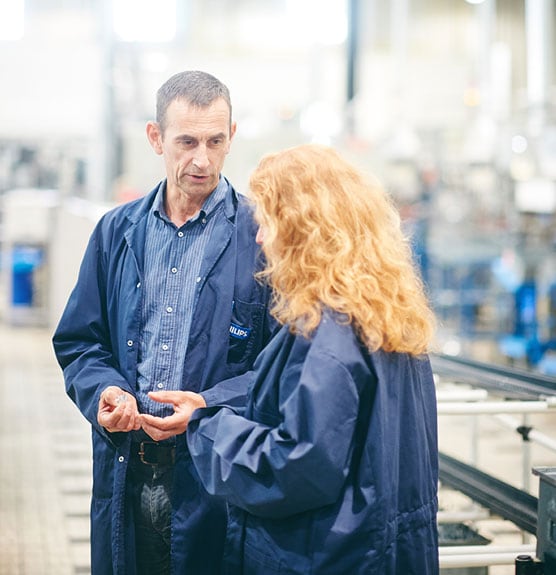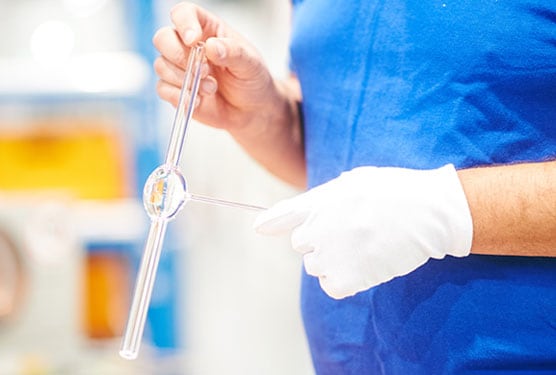The challenge
Manufacturing high-intensity discharge (HID) lamps, Philips Lighting in Turnhout is in an industry that declines by up to 20 percent annually, and its maintenance budget must mirror that drop. That means the business needs to get creative in finding ways to increase efficiency and decrease costs if it’s to not just maintain, but increase its share of the sector, and that’s where 3D printing comes in.
Philips Lighting has a huge portfolio of more than 46,000 stock keeping units (SKUs) that are required to keep the site operational. That ties up a massive five percent of the firm’s annual revenue in spare part inventory alone – the site’s annual repair and maintenance budget represents three percent.
Not only is the massive stock costly to store and manage, it also creates complexity. And when machines are upgraded or changed, some parts become obsolete and can no longer be used, so are simply wasted.
To help find a solution – and free up financial resources to use elsewhere in the business, Philips Lighting tasked PwC with investigating the business potential for 3D printing in its overall spare part supply chain.


Business opportunities of 3D printing
PwC first mapped the supply chain to find where 3D printing could have an impact on supply chain processes. Four areas were identified – sourcing, inventory, production and maintenance. Based on this, it became clear that 3D printing could indeed provide significant opportunities for optimising the spare part supply chain.
3D printing allows you to create shapes that aren’t possible with traditional manufacturing, which means functionality can be enhanced, the lifetime of a unit can be increased and you can use less material to create a unit, saving cost. You can also choose to make units out of different metals or materials to increase their durability, helping reduce required repair time for machines. The technology also allows for prototyping and more rapid iterations, helping shorten the design cycle, and can result in a better design.
With 3D printing, it’s also easier to involve internal and external stakeholders in the process. The ability to print a unit on demand as when required means there no longer needs to be a physical stock of SKUs – the inventory can be kept in a virtual format -, helping reduce working capital, reduce the risk of obsolescence and making it much easier to upgrade parts when required. This also reduces the lead time of units and removes the need to transport finished products.
One of the major advantages of 3D printing is that complex assemblies can be printed in one process, eliminating points of failure where there were previously joins, again reducing repair time and costs.
Bringing appropriate parties together
Knowing not only the business of 3D printing, but also the players in the market that could support the project, PwC proved our added value by bringing together appropriate parties with deep expertise in the field of 3D printing technology: a provider of 3D Printing software and services and a specialist in metal 3D printing.
We were also able to call in required expertise from across the PwC network, both in Belgium and beyond, to deliver a full service offering, including operational/supply chain knowledge, Big Data analytics and technology capabilities on an international scale.

"Teamwork was an essential part of the project. Without PwC, we wouldn’t have known where to begin and wouldn’t have had access to service providers and subject-matter experts who made sure that all supply chain aspects were covered."
Flexible design
Based on the possibilities afforded by 3D printing, we identified four ways in which units could be produced:
Copy-paste
The same part produced using 3D printing technology
Assemble
Create a unit in one 3D print job that was originally made up of two
Upgrade
Use 3D printing to produce an improved part
Downgrade
Produce a minimum viable part as a temporary solution to an issue
Putting ideas into practice
The entire stock of 46,778 SKUs was filtered according to set criteria to identify which units could be positively impacted by 3D printing. The criteria included lead time for delivery, minimum order quantity (MOQ), whether Philips owns the intellectual property (IP) rights, size and price. With such an immense amount of data to analyse, PwC called in our data analytics experts to help, which made the process very efficient and was much appreciated by the client.
These criteria brought the viable number of units to nine percent of the portfolio, which make up 18% of the inventory value. From these, five spare parts were selected to trial, each with different supply chain drivers. For each unit, the annual operational costs were mapped, the part redesigned (where deemed necessary), printed and tested, and the business case calculated.

"3D printing has proven its worth to Philips Lighting’s supply chain in terms of helping us better manage our stock of units and increase the quality of units, which in turn reduces required repair time. This could have substantial implications not just for our plant, but Philips Lighting as a whole."
Proving the point
The business case for the five 3D printed parts represented an expected 30% reduction in OPEX costs and saw an increase in the lifetime of the units and an improved quality process.
As such, it’s clear that 3D printing offers significant potential to improve the spare part supply chain at Philips Lighting in Turnhout, from both technical and supply chain perspectives. However, given the specific nature of the project and parts in question, the results cannot be extrapolated to the rest of the inventory, each part needs to be investigated separately.
And despite the impressive results – which have helped increased stakeholder enthusiasm for the concept -, there are still obstacles to overcome before 3D printing can be further implemented at the firm. It takes a lot of time to finalise a full spare part case due to the amount of time required for iterations, testing and capability building.
However, the project was successful in demonstrating that 3D printing can transform the supply chain for spare parts over the longer term. It also helped remove the ‘fear’ factor of the unknown for technicians working with the newly printed parts.

Going forward
Further development of 3D printing capabilities at Philips Lighting in Turnhout is still under investigation with technicians already looking for new units that may be positively impacted by the technology, based on the five successful cases. The aim is to continue to build up a library of viable examples where 3D printing can positively influence the business and save much-needed costs, helping to further increase the buy-in of stakeholders.
Project learnings are also being shared with other Philips Lighting facilities around the world to see if it’s viable to embed 3D printing into the company’s overall parts management approach.
Contact us










